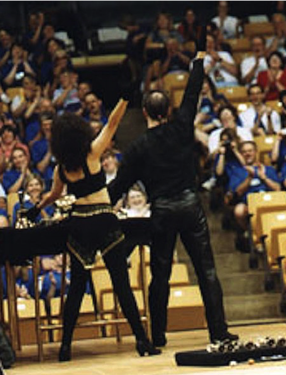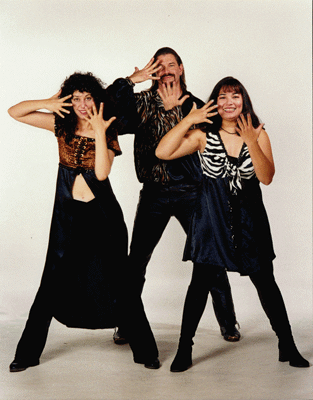This is an excerpt of an article written by Campanile co-founder Rima Greer for use in publications of Handbell Musicians of America. It explains the evolution of what became Handbell Theatre, which is basically the story of Campanile's evolution.
If you are a handbell musician, it has some great tips on what to look for while watching the videos. Some of the most innovative techniques Campanile created were designed to be invisible. Don't miss the opportunity to peek behind the curtain by reading on!
THE BEGINNING...
Campanile was formed in 1987 as a handbell group that wanted to play music not usually associated with handbells. The first pieces I remember playing were by Paul Desmond and Oscar Peterson, which, believe me, were revolutionary ideas at the time. Not so much now, partly, I hope, because of us. But at the time, it was crazy. We even had handbell experts come up to us and say, “You can't do that.”
I was the only person who had no prior handbell experience. But I did have tons of theatre and dance experience. It was only a few months into the process when the group asked me to add choreography to the music we were playing, and from there we went on to create full two-hour shows that were thematic from end to end.
As our group evolved, we would create a show, tour it for a couple of years, and then build a new one. I'm going to talk about three of them – the first, the middle, and the last, which tracks the evolution of HT from the very first baby steps, to what it became by the time we retired.
CAMPANILE IN CONCERT
Our first full show was basically a collection of popular tunes that you would not expect to hear on bells. We all danced as we rang, but we were still behind the tables. Between pieces we basically did standup comedy. We called our video Campanile in Concert – because we were still lacking a concept – we were still just doing the coolest stuff we could think of on bells.
It all sounds pretty tame now, but even then, we made some huge departures from what the rest of the handbell universe was doing at the time: We did not drape our tables, so you could see our legs; we danced; we had no conductor; we wore sexy costumes instead of uniforms; we played popular music, not handbell or classical music; and after the first year or so, we always had a drummer. A real drummer, with a whole kit, not one person with a tambourine now and then.
However, in my mind, the most important thing we did from the very beginning was to create a relationship with the audience, and characters for ourselves. It might have been the very first time handbell musicians had ever made eye contact with the audience. And we did so “in character” – basically we each became our own favorite rock star, and performed as that person.
Please note, I didn't say “we pretended to be rock stars.” I said, we “became” rock stars. It's the difference between BEING Lady Gaga, and being Weird Al PRETENDING to be Lady Gaga. Both are entertaining and valid. But one is Theatre, and the other is Parody.
That first show was the very beginning of the creation of Handbell Theatre. We memorized our music so we could interact with each other and the audience, added choreography, and started the process of creating characters.
NOCTURNAL JOURNEYS
Next, we created a show that had a single cohesive theme – Nocturnal Journeys. Instead of just choosing this song and that song because we liked them, we wrote a story, and then chose music that would tell that story. We also changed our standup routine into spoken word story, that moved the show along its arc. And, after the first “Standup Show,” we never EVER talked about the bells themselves.
This is also when we changed our table configuration. We had always performed in a U or an L, but we were determined to break down the barrier between us and the audience. For the next show, we built eight 3X3 tables on wheels, so that the configuration of the tables could change between every piece, and so we could stand NEXT to them, not behind them. This opened up whole new dancing and relationship opportunities. Once you break that table barrier, a whole lot is up for grabs!
That second show added to the evolution of HT: No table barrier, cohesive story, more dancing, more character. But the biggest step towards HT in this show is invisible, unless you know where to look for it.
This is the show where we came up with the concept of “interstitial” pieces – smaller pieces that could be played with two or three people, so that everyone else could change their bells out (or do a costume change) without losing momentum in the show. Nothing stops a show colder than making the audience wait for you to set up, even if you have a talking head in front. We wanted those interstitials to be an integral part of the show, so the audience wouldn't even realize that the bell changes were going on.
RITES OF SOUND
Our final show finally brought the whole thing together. This time, we wrote an entire script before we picked piece one of music. Rather than telling stories this time, we would BECOME the characters in the story, and each song would move the story along.
Now movement was not only an accompaniment to the music, it was actually integral to acting out the story.
But that's not all. The moment we invented Handbell Theatre is the moment when we threw out the concept of assignments.
Let's talk about assignments for a minute. Because you can't possibly do real HT without revising your idea of assignments.
THE SECRETS BEHIND THE MAGIC
Most handbell groups play their set chromatically. Some might move a few bells here and there. But to really do HT, you have to assign along musical lines.
In Noctural Journeys, watch carefully as we are playing Barock. Notice that the melody is being played by three people. About half way through, I take over playing the “brass stingers,” Kat & Kristin take over the melody. The bass is being played by Roger and Ron. Kris is the only one who moves back and forth between bass, harmony, and melody. This makes for exceptionally clean lines, and a musical line that the audience can identify visually. It also leaves time and space for the performers to dance.
There are two, maybe three people in the world who are experts at this kind of assigning. One of them is KatRyn Howell. I'm sure she'd be happy to give you lessons. She's on the Area XII Board. Drop her a note if you're interested.
But let's take another step backwards…. you also can't achieve Handbell Theatre without compositions and/or arrangements that are suited to it. If you try to do HT by ringing standard stacked handbell music, you are likely doomed to failure. You're either going crazy with huge assignments, or you spend all your time waiting for the musical line to get to you, or you're hanging on to two bells to save your life with no place to put your accidentals, or no way to dance because your hands are full of 4IH 100% of the time. It's also much easier to memorize assignments that are drawn along musical lines.
So, how do you write/arrange for HT? That's a whole other article. Or, more likely, three days in a classroom. Drop me a note if you're interested in writing, arranging, or performing HT.
OK, here's the reason for that digression. For our final show, we discarded assignments altogether. Or, more precisely, we discarded the idea of assignments for a piece. Let me explain.
The underlying visual concept of our final show was to create movement across the stage as much as possible. No longer would we be chained to dancing in place, next to a table. So we chopped up our assignments into modules.
Play the melody for 8 bars. Take three bells from here, put them on someone else's table, dance for a while, or play another instrument, pick up bells from somewhere else, and start ringing again 16 bars later. Everyone is doing that continuously through an entire song.
If that sounds crazy, you're right. It's completely nuts. It means you have to memorize your music BEFORE you rehearse it, because you can't stand at a table and read the music. It means that you have to play the WHOLE set, not just “your bells.” It means you have to be on time, every time, or not only can you not play properly, but the person you're delivering the next module to can't either. It's an insane tightrope walk where anything can go wrong at any given time. It's also the most fun I've ever had in my life.
*************
Campanile Core Cast Members:
Roger Bowerman*
Rima Greer*
KatRyn Howell*
Kris Wildman*
Terry Halvorson
Campanile Cast:
Johnanna McWhirter
Kristin Paul
Barbara Silvey
Ron Dotson*
Barbara Silvey
Karen McWilliams*
Francisco Crow
SungHee Kim
Additional Cast:
Steve Reid
Michael Bissonette
Reid Defever
John Cardoso
Jesse Oquist
Jeff Batdorf
Nick Hanson
*Founding Members


Rima, Roger
Rima, Roger, Johanna
Roger, Rima, Kris, KatRyn, Terry

